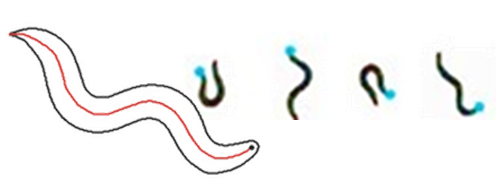
The rotation index is a mathematical calculation that assesses how the overall shape of the worm changes over time. It is particularly useful for distinguishing between worms that are inactive and those that are merely rotating in place, as observed in certain roller strains. For instance, in the context of a paralysis assay where worms exhibit a low motility index, two scenarios arise:
- A low motility index with a low rotation index value typically indicates that the worms are motionless.
- A low motility index with a high rotation index suggests that the worms are engaged in rolling movements.
Calculation of Rotation index:
For each detected worm, its silhouette is compressed and converted into a binary matrix with a resolution of 4 pixels by 4 pixels, where a value of 1 indicates the presence of a part of the organism against the background. For example, a worm with a structure such as the one in table 1 below: ‘0000-0001-0111-1110’ is represented by the decimal value 382. This information is saved into a file called ‘xy_worms.bin’ and can be exported in .txt format.

The software then calculates the bitwise exclusive OR (XOR) between the binary matrices of successive frames.

The average of the XOR values for all worms corresponds to the reported Rotation Index, quantifying the amount of rotational movement of the worms over time.
It is important to note that post-analysis of silhouettes' raw data can also be useful for disaggregating the worm shapes to discover the predominant worm body positions over time. For example, this can be achieved by creating a histogram of worm shapes.
